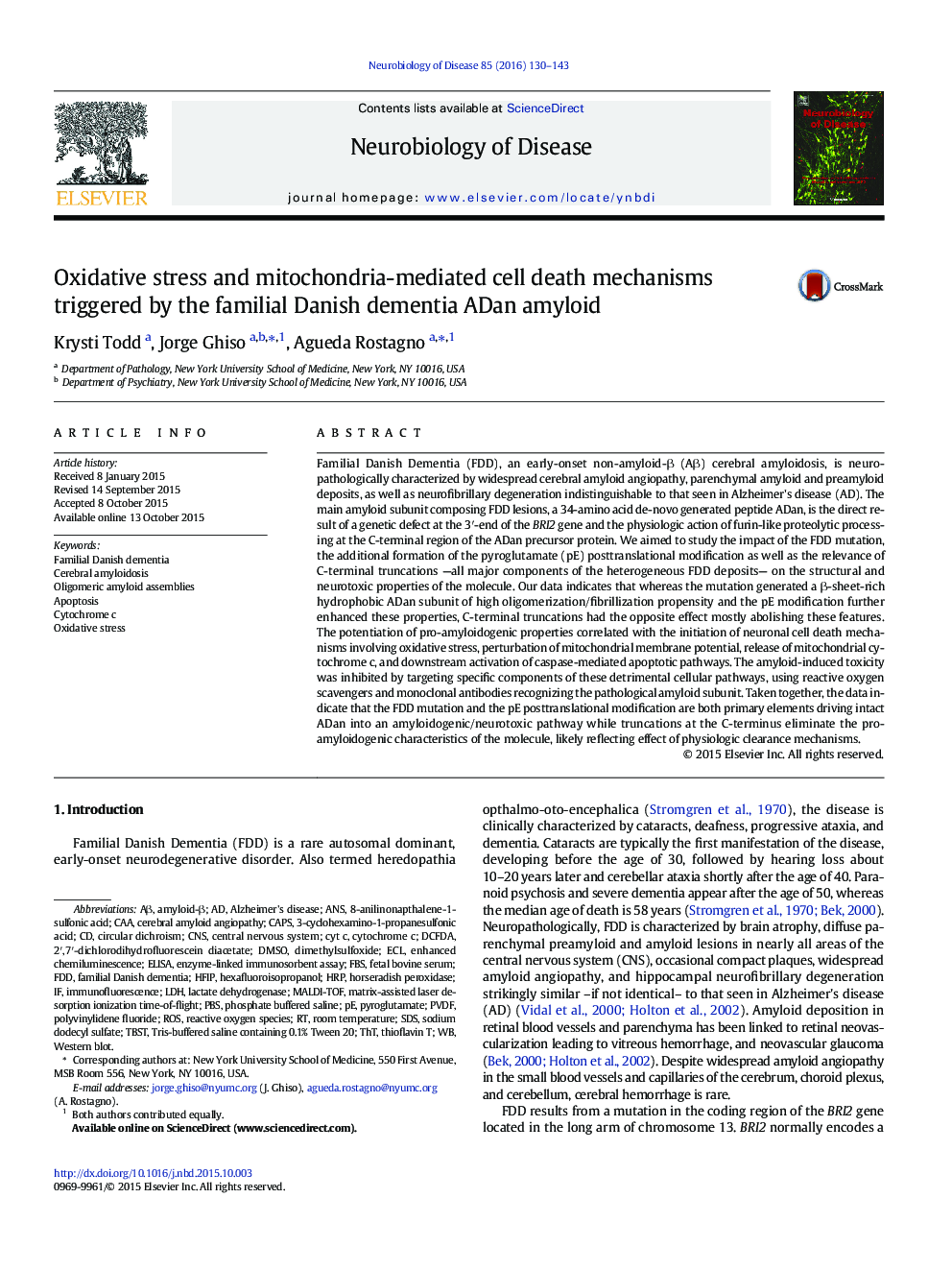| کد مقاله | کد نشریه | سال انتشار | مقاله انگلیسی | نسخه تمام متن |
|---|---|---|---|---|
| 6021530 | 1580638 | 2016 | 14 صفحه PDF | دانلود رایگان |
عنوان انگلیسی مقاله ISI
Oxidative stress and mitochondria-mediated cell death mechanisms triggered by the familial Danish dementia ADan amyloid
دانلود مقاله + سفارش ترجمه
دانلود مقاله ISI انگلیسی
رایگان برای ایرانیان
کلمات کلیدی
FDDCAAAβHRPECLHFIPPVDFMALDI-TOFCyt CTBSTFBSSDSDCFDACAPSPBSCerebral amyloidosishexafluoroisopropanolTris-buffered saline containing 0.1% Tween 202′,7′-dichlorodihydrofluorescein diacetate - 2 '، 7'-dichlorodihydrofluorescein diacetateDMSO - DMSOROS - ROSamyloid-β - آمیلوئید βcerebral amyloid angiopathy - آنژیوپاتی آمیلوئید مغزیImmunofluorescence - ایمونوفلورسانسThT - بلهenhanced chemiluminescence - بهبود شیمیایی لومنAlzheimer's disease - بیماری آلزایمرELISA - تست الیزاEnzyme-linked immunosorbent assay - تست الیزاOxidative stress - تنش اکسیداتیوThioflavin T - تیوفلاوین TApoptosis - خزان یاختهایCNS - دستگاه عصبی مرکزیRoom temperature - دمای اتاقDimethylsulfoxide - دیمتیل سولفواکسیدcircular dichroism - رنگ تابی دورانیmatrix-assisted laser desorption ionization time-of-flight - زمان پرواز یونیزاسیون لیزر جذب ماتریسFamilial Danish dementia - زوال خانواده دانمارکیANS - سالsodium dodecyl sulfate - سدیم دودسیل سولفاتfetal bovine serum - سرم جنین گاوcytochrome c - سیتوکروم سیcentral nervous system - سیستم عصبی مرکزیPhosphate buffered saline - فسفات بافر شورlactate dehydrogenase - لاکتات دهیدروژناز LDH - لاکتات دهیدروژناز به صورت مختصر شده LDH Western blot - وسترن بلاتHorseradish peroxidase - پراکسیداز هوررادیشPyroglutamate - پری گلوتاماتPolyvinylidene fluoride - پلی وینیلیدین فلورایدReactive oxygen species - گونههای فعال اکسیژن
موضوعات مرتبط
علوم زیستی و بیوفناوری
علم عصب شناسی
عصب شناسی
پیش نمایش صفحه اول مقاله

چکیده انگلیسی
Familial Danish Dementia (FDD), an early-onset non-amyloid-β (Aβ) cerebral amyloidosis, is neuropathologically characterized by widespread cerebral amyloid angiopathy, parenchymal amyloid and preamyloid deposits, as well as neurofibrillary degeneration indistinguishable to that seen in Alzheimer's disease (AD). The main amyloid subunit composing FDD lesions, a 34-amino acid de-novo generated peptide ADan, is the direct result of a genetic defect at the 3â²-end of the BRI2 gene and the physiologic action of furin-like proteolytic processing at the C-terminal region of the ADan precursor protein. We aimed to study the impact of the FDD mutation, the additional formation of the pyroglutamate (pE) posttranslational modification as well as the relevance of C-terminal truncations -all major components of the heterogeneous FDD deposits- on the structural and neurotoxic properties of the molecule. Our data indicates that whereas the mutation generated a β-sheet-rich hydrophobic ADan subunit of high oligomerization/fibrillization propensity and the pE modification further enhanced these properties, C-terminal truncations had the opposite effect mostly abolishing these features. The potentiation of pro-amyloidogenic properties correlated with the initiation of neuronal cell death mechanisms involving oxidative stress, perturbation of mitochondrial membrane potential, release of mitochondrial cytochrome c, and downstream activation of caspase-mediated apoptotic pathways. The amyloid-induced toxicity was inhibited by targeting specific components of these detrimental cellular pathways, using reactive oxygen scavengers and monoclonal antibodies recognizing the pathological amyloid subunit. Taken together, the data indicate that the FDD mutation and the pE posttranslational modification are both primary elements driving intact ADan into an amyloidogenic/neurotoxic pathway while truncations at the C-terminus eliminate the pro-amyloidogenic characteristics of the molecule, likely reflecting effect of physiologic clearance mechanisms.
ناشر
Database: Elsevier - ScienceDirect (ساینس دایرکت)
Journal: Neurobiology of Disease - Volume 85, January 2016, Pages 130-143
Journal: Neurobiology of Disease - Volume 85, January 2016, Pages 130-143
نویسندگان
Krysti Todd, Jorge Ghiso, Agueda Rostagno,